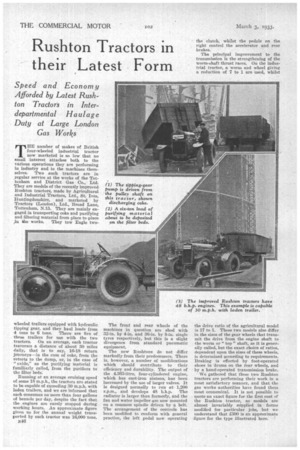Rushton Tractors in their Latest Form
Page 64

If you've noticed an error in this article please click here to report it so we can fix it.
Speed and Economy Afforded by Latest Rushton Tractors in Interdepartmental Haulage Duty at Large London Gas Works
THE number of makes of British four-wheeled industrial tractor now marketed is so low that no small interest attaches both to the various operations they are performing in industry and to the machines themselves. Two such tractors are in regular service at the works of the Tottenham and District Gas Co., Ltd. They are models of the recently improved Rushton tractors, made by Agricultural and Industrial Tractors, Ltd., St. Ives, lluntingdonshire, and marketed by Tractors (London), Ltd., Broad Lane, Tottenham, N.15. They are mainly engaged in transporting coke and purifying and filtering material from place to -place „in the works. They tow Eagle two'
wheeled trailers equipped with hydraulic tipping gear, and they haul loads from 4 tons to 6 tons. There are five of these trailers for use with the two tractors. On an average, each tractor traverses a distance of about 30 miles daily, that is to say, 18-18 return journeys—in the case of coke, from the retorts to the dump, or, in the case of "oxide," as the purifying material is familiarly called, from the purifiers to the filter beds.
Running at an average cruising speed of some 18 m.p.h., the tractors are stated to be capable of exceeding 30 m.p.h. with laden trailers, and we are informed that each consumes no more than four gallons of benzoic per day, despite the fact that the engines are rarely stopped during working hours. An approximate figure given us for the annual weight transported by each tractor was 16,000 tons.
1346 The front and rear wheels of the machines in question are shod with 32-in. by 4-in. and 36-in. by 8-in. single tyres respectively, but this is a slight divergence from standard pneumatic equipment.
The new Rushtons do not differ markedly from their predecessors. There is, however, a number of modifications which should contribute to their efficiency and durability. The output of the 4.363-litre, four-cylindered engine, which has east-iron pistons, has been increased by the use of larger valves. It is designed normally to run at 1,200 r.p.m., and develops 48 b.h.p. The radiator is larger than formerly, and the fan and water impeller are now mounted on a common spindle driven by a belt. The arrangement of the controls has been modified to conform with general practice, the left pedal now operating the drive ratio of the agricultural model is 17 to 1. These two models also differ in the sizes of the gear wheels that transmit the drive from the engine shaft to the worm or" top" shaft, as it is generally called, but the exact choice of ratios, dependent upon the sizes of these wheels, is determined according to requirements. Braking is effected by foot-operated shoes in drums on the tear wheels, and by a hand-operated transmission brake.
We gathered that these two Rushton tractors are performing their work in a most satisfactory manner, and that. the gas works authorities have found them most economical. It is not possible to quote an exact figure for the first cost of the Rushton tractor, as models are almost invariably supplied in forms modified for particular jobs, but we understand that 1300 is an approximate figure for the type illustrated here.




































































































